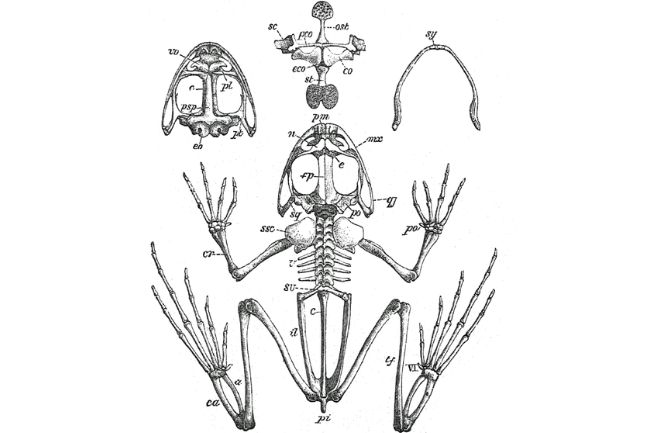Frogs do have a backbone, also known as a spinal column. This is made up of vertebrae, meaning they are vertebrate animals.
What is a Backbone?
The backbone is what is usually referred to as the spine. The spine, or spinal column, is made up of a series of vertebrae. Vertebrae are irregularly shaped bones that provide flexibility and movement to the center of an animal’s body. The spine extends from the skull to the pelvis.

It’s the presence of the vertebrae in an animal that means it is classed as a vertebrate animal. Animals without vertebrae are grouped together as invertebrates. While vertebrates are distantly related, invertebrates range widely, from jellyfish, to insects, to crabs.
Many animals with backbones are what is known as tetrapod vertebrates, meaning they have four legs along with their backbone. Frogs are included in this, as they have four legs and a backbone, once they have become adults.
Also read: Is Snail Vertebrate or Invertebrate? (Let’s Find Out)
A Frog With a Backbone
Frogs have around 10 vertebrae, though the exact make up of a frog’s skeleton can depend on the species. Humans by comparison have 33 vertebrae.
Another interesting aspect of a frog’s backbone is that they lack a neck. Without a neck frogs are unable to turn their head, however, this is also a lot safer for them when making their fantastic jumps, which could otherwise result in a broken neck.
A Frog’s Skeleton
A frog’s skeleton may look fairly alien at first glance, but the pattern is very similar to that of other vertebrates.
The frog’s skull is fairly large and flat, compared to the rest of the skeleton. This is in part because of the frog’s large mouth, which allows it to swallow its prey whole.

The central spinal column connects to four limbs. Of these the back legs are the largest and most significant, as their powerful limbs allow them to jump long distances.
Beyond the lack of a neck, frogs also have a number of other bodily anomalies. Frogs have no ribs, something that significantly impacts how they breathe. As well as no ribs, frogs lack a diaphragm. In many vertebrates the diaphragm and ribs control the movements of the lungs, allowing breath to move in and out by expanding and compressing the lungs.
Instead of the diaphragm and ribs to control the frog’s breathing, frogs use their mouths to push air into their lungs. This occurs by the frog’s pulling air into their mouth through their nose. As they breathe in, the opening to their lungs is closed. They then close their mouth and nose and open their lungs, allowing the air from their mouths in.
Another unusual aspect of most frogs is that all their internal organs are located with one cavity. Within many vertebrates, organs are stored in several cavities, such as the chest, abdomen, and pelvis.
Also read: Limb Regeneration: Can Frogs Regrow Their Legs?
Do Tadpoles Have Bones?
Most frogs start out as tadpoles, which themselves hatch from eggs. When young, tadpoles don’t have legs and are simply oval forms with long tails.
They start life without bones, instead having a cartilaginous skeleton. As they grow, bones, including a spinal column, develop. During this transformation they also grow legs, and slowly lose their tails.
Finally, they emerge from the water as froglets. Like other vertebrates, a frog’s skeleton will grow with the rest of its body, supporting the weight of its organs and muscles as they develop.

Also read: Frog Reproduction and Their Life Cycle
Where do All The Skeletons Go?
A frog skeleton would certainly be an exciting thing to see, yet few of us get the chance to observe them first-hand. This is in part because most frog species are so small, meaning their skeletons are relatively tiny and fragile.
Many frogs are also eaten, and their skeletons consumed by whatever bird, fish or mammal has swallowed them.
Even if a frog is lucky enough to die of old age, skeletons are quickly decomposed by bacteria and other decomposers. And besides, many animals choose to move out of sight when their time comes, so as not to be at risk from predators.
Perhaps the most fascinating thing you can observe, if you ever do get the chance to see a frog skeleton up close, is how similar they are to our own. From frogs to cats to humans, perhaps the best way to see how alike our building blocks are is to look beneath the skin, at the very backbone of what we are.

